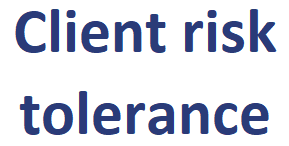Client risk tolerance
Client risk tolerance is typically assessed using a combination of questionnaires and conversations. Conversations are useful because they complement questionnaires and may yield additional information about a private client’s risk tolerance that may be difficult to obtain from a questionnaire as well as enable the wealth manager to educate clients about investment risk.
On this page, we discuss the different ways in which a client’s risk orientation can be described.
Client’s risk orientation
There are three ways in which we can describe a private client’s risk orientation:
- risk tolerance: this reflects both the client’s willingness and ability to take risks. The opposite of risk tolerance is risk aversion
- Risk capacity: this addresses a private client’s ability to take financial risks, based on the client’s wealth, income, investment horizon, liquidity requirements, importance of goals, and other relevant considerations. The higher the risk capacity, the greater the ability of the client’s portfolio to sustain losses without putting the client’s goals in jeopardy. Risk capacity is a more objective measure compared to risk tolerance, which can be viewed as more of an attitude toward risk.
- Risk perception: This is defined as a subjective measure of investment risk (e.g. whether a private client thinks of investment losses in absolute or percentage terms). Risk perception varies from one private client to the next: a wealth manager can play a part in influencing a client’s risk perception.
The ability to bear risk is decreased by:
- a shorter time horizon
- larger critical goals in relation to the size of the portfolio
- goals that are important to the client or those that cannot be deferred
- high liquidity needs
- situations where the portfolio is the sole source of support or there is an inability to losses in value.
Note that when clients have multiple financial goals, the wealth manager should determine the client’s risk tolerance for each goal.
Summary
We discussed three different ways in which a private wealth manager can think about a client’s risk orientation. Wealth managers should be mindful of framing bias when evaluating the risk tolerance of clients.

